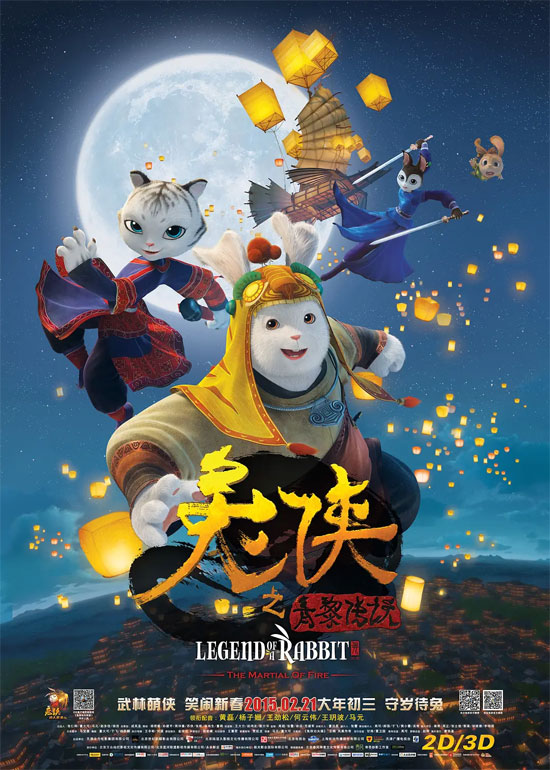Film Name: 兔侠之青黎传说 / Legend of A Rabbit: The Martial of Fire

This film marks the first time I’ve seen a standard Hollywood-style reversal in a domestic animated movie—turning the original villain into the hero and the original hero into the villain. Precisely because of this reversal, the film’s other shortcomings—its tedious pacing, shallow characterization, and simplistic storytelling—don’t overshadow it as its most prominent feature.
In terms of the visual design of the Rabbit Hero character, it shows improvement over the genuinely “second-rate” Rabbit Two from a few years ago. The face has evolved from stiffly plastic to adorably goofy, and the voice no longer mimics Fan Wei’s distinctive nasal tone, giving it a hint of heroic potential. Yet in terms of character development, he remains utterly lacking. I even question whether the director and screenwriter ever seriously considered how this character should think or live.
If the first half aimed to portray his complacency, arrogance, or loss of direction, it should have been more thorough. Let him bask in the people’s praise, make him deaf to any advice from Peony or Two-Meter-Tall, and strip him of any motivation to train—until he faces a setback. If the latter half aimed for redemption and renewed determination, then the catalyst for his self-reflection should never have been Peony’s formulaic, half-hearted speech. Was his ultimate motivation to move forward truly just “no matter what, I must keep going”?
Why did Gao Liangmi’s fall off the cliff suddenly trigger Tu Er’s breakthrough to a state of harmony? If Rabbit Two were truly heroic, if he genuinely valued the two-meter height, he should have leapt off the cliff to save his friend. In that act of rescue, driven by the urge to protect, new strength should have emerged—not the helpless howling at the cliff’s edge followed by a sudden burst of ultimate power as depicted in the film. Elder Zhan’s final self-detonation was undoubtedly a simplistic resolution, as it denied Rabbit Two the chance to demonstrate his ultimate power. If every schemer in the world self-destructed when their plots were about to succeed because they couldn’t control that power, there truly would be no more schemers.
While the film appears to build momentum gradually, it contains numerous ineffective plot elements and questionable choices. For instance, the scene where Elder Zhan escapes opens with sweeping vistas of majestic mountains and grandiose music—material that should have been reserved for the opening animation. Such a sequence would have instantly captured the audience’s attention and subtly foreshadowed the plot’s reversal. Following this, the scene should have shown Rabbit Hero dispatching thieves with ease in the night market, basking in public acclaim. This sequence could have been streamlined, yet its core message remains unclear. Then comes the conflict between Rabbit Er, Peony, and the two-meter-tall figure over whether to continue training.
At this point, Tu Er must develop a deeper connection with the two-meter-tall figure. Otherwise, the latter’s fall off the cliff would fail to inflict significant psychological trauma, thereby preventing the unleashing of ultimate power. The training sequence depicted in the film serves only as a comedic gimmick, entirely disconnected from the main plot and the characters’ psychological development. When Elder Zhan persuades Rabbit Two to break through the ice wall and retrieve Qingli, his speech should conclude with a sinister smile. Otherwise, the audience will perceive his reversal as entirely unwarranted.
As a masked enigma, the White Ape must have his identity revealed. Otherwise, it insults the audience’s intelligence. Viewers constantly speculate: Who is he? Good or evil? Does he have a backstory? Why does he follow Elder Zhan? Will there be a surprise twist? You cannot reduce such a character to a mere sidekick defeated without consequence.
The film suffers from a persistent flaw in Chinese animation: protagonists outside the schemers’ camp consistently rely solely on brute force to solve problems, never employing intellect to overcome obstacles. As the guardian leader of Qingli, Bailan displays almost no discernible intelligence. It’s hard to imagine how such a hotheaded, violent woman could ever lead a sect into the future. During the trap-navigation sequence, the trio advances under an invincibility aura. Even when trapped under rocks, they passively await rescue by three pangolins. This lack of strategic depth is precisely why Chinese animation, despite aiming for adult audiences, struggles to truly capture their attention.
Most of the film’s action unfolds at night or in dimly lit settings. Combined with the 3D glasses, the colors appear even more muted, making viewing tiring and unsettling. This isn’t a horror film—why so many dark scenes? Couldn’t Rabbit Knight’s first appearance have happened in a daytime marketplace? Couldn’t Bai Lan’s search for people happen during daylight? Couldn’t the fight between White Ape and Elder Zhan in the bamboo forest have brighter lighting?
Finally, one merit: the film’s music is exceptionally well-crafted, rivaling Hollywood blockbusters, effectively setting the mood for each scene. Hopefully, the plot of “Legend of A Rabbit 3” will truly live up to such musical excellence.
Please specify:Anime Phone Cases » Legend of A Rabbit: The Martial of Fire 2015 Animation Film Review: Reversal